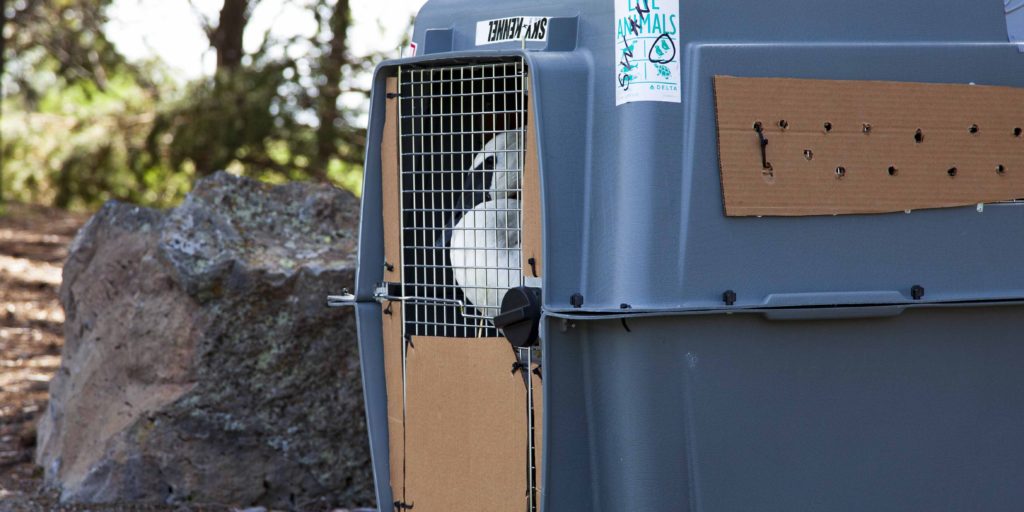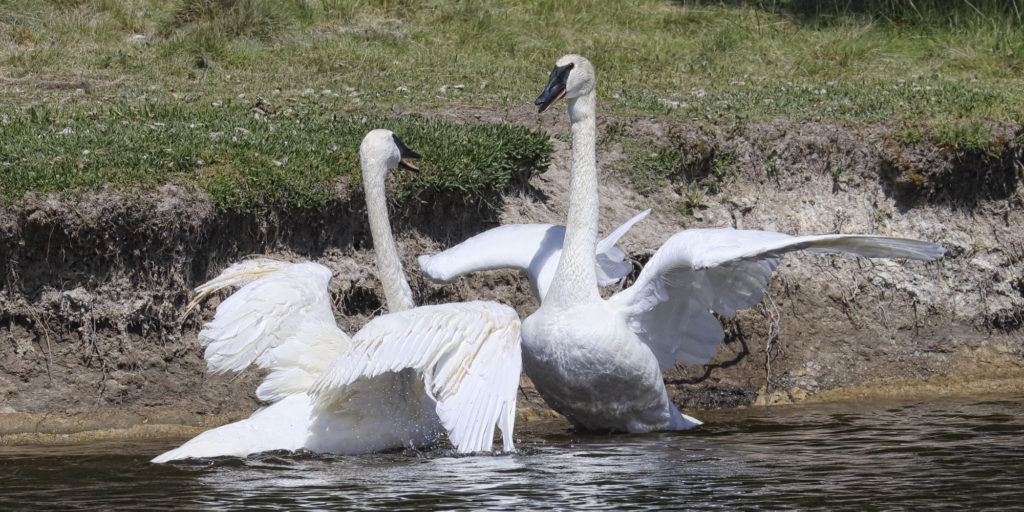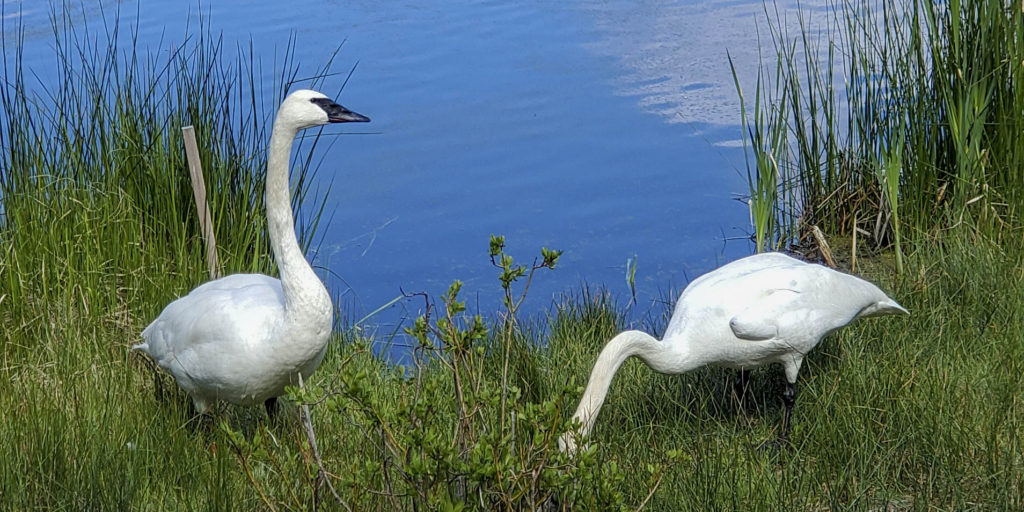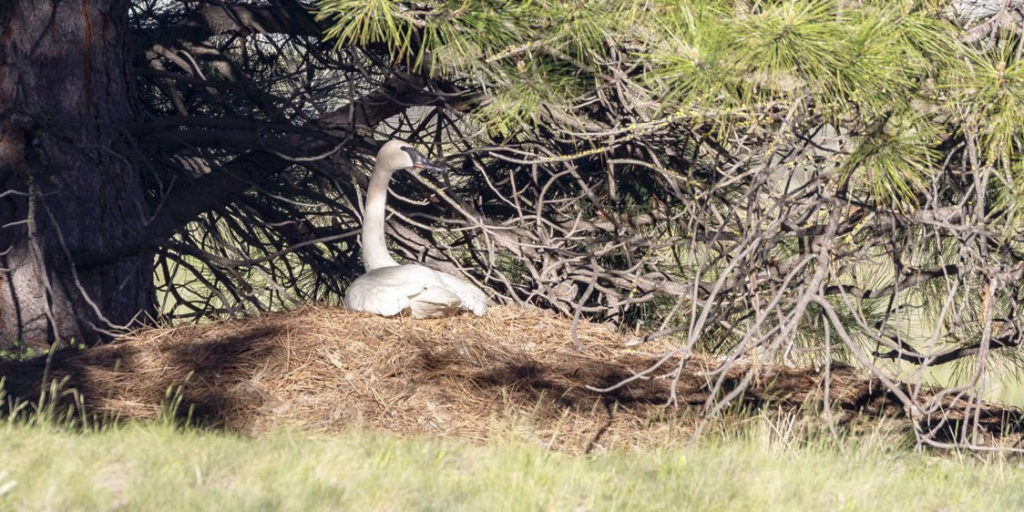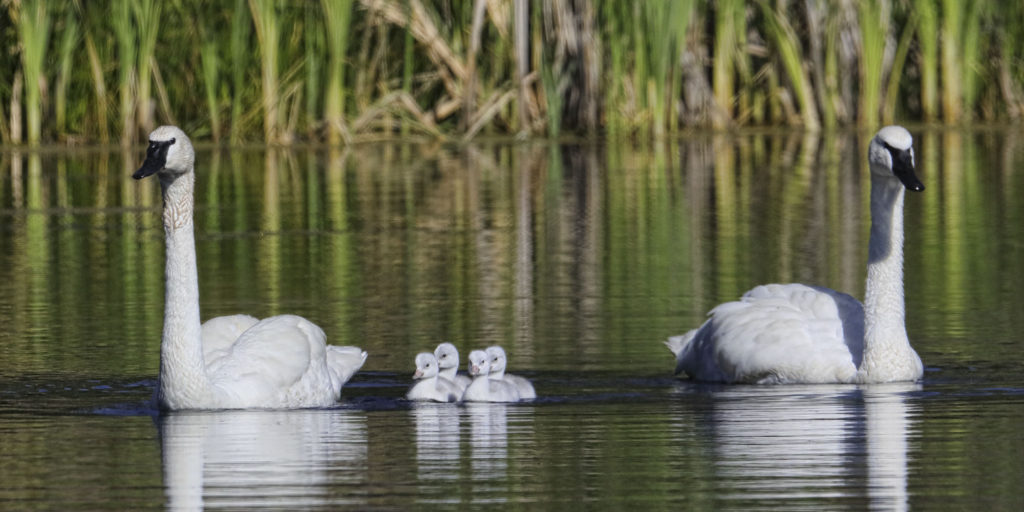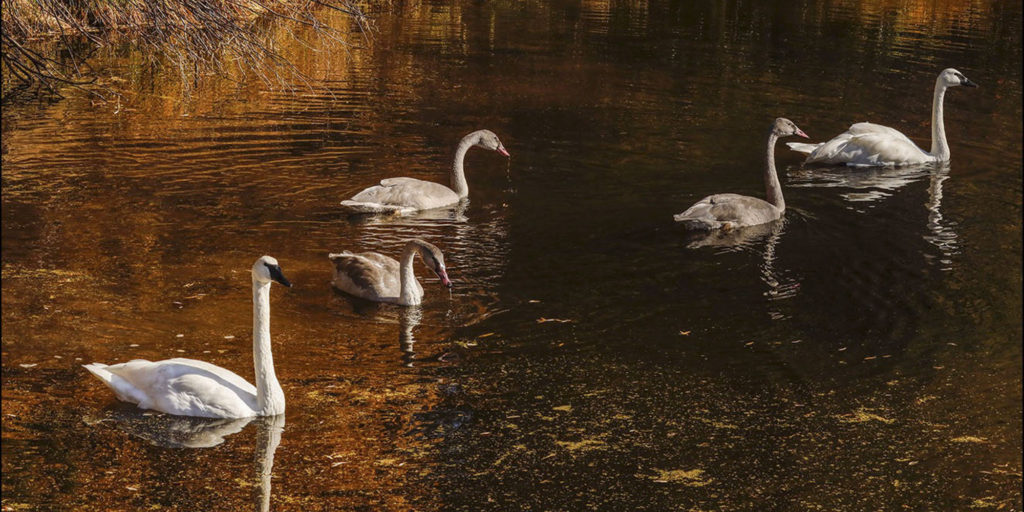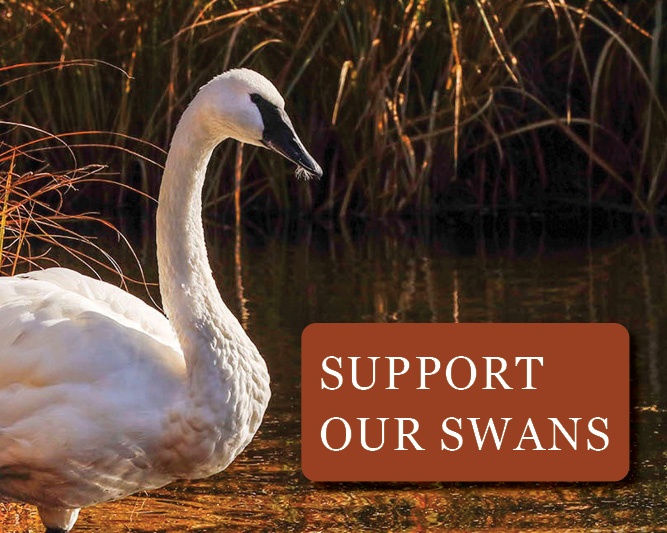Trumpeter Swans from Sunriver Nature Center
Wildlife Conservation – One Swan at a Time
Sunriver Nature Center & Observatory has hosted a pair of breeding Trumpeter Swans on adjacent Lake Aspen since 2015. Since then, 11 cygnets have been released into the wild at Summer Lake Wildlife Area through Oregon’s Trumpeter Swan Restoration Program.
Each cygnet born brings us closer to a thriving and sustainable population of Trumpeter Swans in Oregon. After nearly being hunted to extinction in Oregon in the early 1900s, this species has been slow to recover in part due to loss and degradation of wetland habitats. However, through the efforts of The Trumpeter Swan Society, Oregon Department of Fish and Wildlife, Malheur National Wildlife Refuge, and many other partners, there will be a future for Trumpeter Swans in Oregon once again.
Through our commitment to hosting Trumpeter Swans in Sunriver and caring for the growing cygnets during a critical period in their development, we play a role in helping to restore Oregon’s natural heritage. We know that local conservation initiatives can have large scale impacts and Sunriver Nature Center & Observatory is proud to contribute to this important project, one swan at a time.
To learn more about Trumpeter Swans, click the links below.
Partners in Trumpeter Swan Conservation
Trumpeter Swan Society – Plymouth, Minnesota
Oregon Department of Fish and Wildlife
Malheur National Wildlife Refuge – Princeton, Oregon
Summer Lake Wildlife Area – Summer Lake, Oregon
W.K. Kellogg Bird Sanctuary – Augusta, Michigan
History of Oregon’s Trumpeter Swan Reintroduction Program
The Trumpeter Swan Society, along with key partners, Oregon Department of Fish and Wildlife (ODFW) and Malheur National Wildlife Refuge (MNWR), has been working to expand breeding Trumpeter Swan numbers and distribution in south-central and southeast Oregon since the 1990s.
In the late 1930s through the 1950s, Trumpeter Swans were released at MNWR to restore this once present Oregon species. The first nesting occurred in 1958 and the MNWR trumpeter swan flock slowly grew until its numbers peaked at 19 breeding pairs and a total of 77 individuals in 1986. Flood conditions in the mid-1980s reduced their productivity and allowed high numbers of common carp to invade traditional MNWR wintering sites and reduce aquatic food supplies, resulting in degraded wetland conditions and a declining trend in swan numbers. Shortage of winter food caused by degraded wetland conditions and low recruitment were the primary factors limiting the population and these problems were compounded by the sedentary behavior of the flock. The MNWR flock has persisted to the present, though the flock is currently very small (four adults) and is in danger of local extinction. MNWR still provides excellent sites for breeding Trumpeter Swans; however, the wintering area in the south Blitzen Valley that the flock is imprinted on is marginal and likely limits the carrying capacity of the refuge for the existing flock. In recent years, brood survival has been minimal, likely due to reduced water availability in the Blitzen Valley.
Although the project originally began in 1991 and some progress was made on establishing a new flock focused on Summer Lake Wildlife Area, the project was halted in 1998 due to political concerns. Unfortunately, most of the new breeding pairs established from the 1990s releases were gone by 2009, when restoration efforts were restored. Since 2009, 9 new pairs have nested in this region, which fledged a total of 17 wild hatched cygnets.
Although hundreds of Trumpeter Swans overwinter in Oregon, as of 2020, only four pairs of swan nested in the wild in the state.
Trumpeter Swans in Sunriver
Sunriver Nature Center & Observatory has hosted Trumpeter Swans on Lake Aspen since 2013 when male swan Chuck was transferred from W.K. Kellogg Biological Station Bird Sanctuary. Sunriver was chosen as a breeding site of Oregon’s Trumpeter Swan Restoration Program for its high quality and relatively protected habitat.
The breeding program got its start in Sunriver in June 2015 when a female swan, Grace, was released on Lake Aspen as a mate for Chuck. Prior to her arrival in Sunriver, Grace was recovered from the Deschutes River in Bend with a fishing lure stuck in her tongue and rehabilitated by Elise Wolf of Native Bird Care of Sisters. The story of Grace’s rescue is documented in the children’s book How Grace Got her Name by Alice Elshoff.
Chapter 1: Chuck & Grace (2015 - 2017)
Grace and Chuck produced two clutches of cygnets during their time together. In summer 2016, the pair produced two cygnets named Fiona and Finley. Later that fall, the cygnets were banded and moved to Summer Lake Wildlife Area. Fiona was subsequently killed in an illegal poaching incident. As of May 2019, Finley survives and is currently in Montana. On July 4, 2017, Grace and Chuck hatched four cygnets. Since the brood hatched late, Oregon Department of Fish and Wildlife made the decision to allow the cygnets to overwinter on Lake Aspen in Sunriver before moving them to Summer Lake Wildlife Area in the spring of 2018.
On Thanksgiving Day, 2017, while Grace and Chuck and their four cygnets were traveling on a portion of the Deschutes River in Sunriver, Chuck was illegally shot. That same evening Chuck was recovered by nature center staff and was humanely euthanized by a veterinarian. A suspect in the shooting was arrested in March 2018 and he subsequently pled guilty. The man was ordered to pay $3,000 in restitution and a $1,000 fine, lost his hunting privileges for three years, was ordered to forfeit his rifle, and served two days in jail and 80 hours of community service. For more coverage on the court case, view the Bend Bulletin article here.
Grace remained alone on Lake Aspen until May, 2019.
Chapter 2: Grace & Gus (2019 - 2020)
A new adult male Trumpeter Swan was released onto Lake Aspen and introduced to Grace, the resident female, on Monday, May 13, 2019. The male swan was transferred from W.K. Kellogg Biological Station Bird Sanctuary. The swan was initially brought to the sanctuary from a rehabilitation facility in December 2018 after recovering from a left wing injury caused by a collision with a power line. The swan was unable to fly due to a significant decrease in the range of motion for his wing and dislocated elbow. He was placed at the Sanctuary temporarily until staff were able to place the swan in a breeding program.
Thanks to an article published in a March 2019 issue of The Bulletin, Sara DePew-Bäby, Animal Caretaker at the sanctuary, learned that Sunriver Nature Center & Observatory was still searching for a male swan to pair with Grace. Sara DePew-Bäby reached out to Amanda Accamando, Nature Center Manager at Sunriver Nature Center & Observatory, and Gary Ivey of the Trumpeter Swan Society, and all agreed that the Michigan swan was potentially a good match for Grace and would be successful on Lake Aspen.
Upon release on Lake Aspen, the male swan and Grace connected almost immediately. Grace greeted the male with head bobs and he reciprocated with a wing display and a quick nip at Grace’s wing in a display of dominance. The following day they were seen mating and establishing a nest site on the island within Lake Aspen. The name Gus was chosen for the male swan to reflect his origin of Augusta, Michigan, where the Kellogg Bird Sanctuary is located.
Grace and Gus successfully nested in 2019 and 2020 producing four and three cygnets respectively. On July 4, 2019, four cygnets hatched from the nest. A couple of months later one of the cygnets disappeared overnight and coyote depredation is suspected. The three cygnets overwintered on Lake Aspen with Grace and Gus and were released in the spring of 2020 to Summer Lake Wildlife Area. In 2020, Grace and Gus nested earlier than usual and three cygnets hatched on June 13, 2020. The cygnets were released at Summer Lake Wildlife Area that fall.
On, October 10, Grace went missing from Lake Aspen and an exhaustive search by air, boat and foot was conducted. A week later her body was found deep in the vegetation of Lake Aspen. Although the cause of death could not be determined, predation by an animal such as coyote or otter is suspected.
Chapter 3: A New Female Swan for Gus (February 2021)
On February 10, 2021, a new female Trumpeter Swan was released onto Lake Aspen as a new mate for Gus.
The female swan, who is four years old, was purchased from a private waterfowl breeder located in Indiana. Due to U.S. Fish & Wildlife limitations on breeding and moving wild migratory bird species and their offspring, only a captive bred swan could be considered for placement in Sunriver at this stage of the program. The female swan is pinioned and cannot fly.
Prior to being released onto Lake Aspen, the swan was held for observation and a health exam was conducted. The swan was released from the shore as dozens of staff, volunteers, and friends of SNCO observed the event. Gus the male swan, who had been standing on a frozen part of the lake, immediately noticed the female and slowly approached her. The two swans swam close to one another for a few minutes before the female drifted away to drink, eat, and preen her feathers.
It will be another couple of months before mating and nesting behaviors are expected from the two swans. However, the staff and Sunriver community are hopeful that the two swans will form a strong pair bond and produce cygnets this year. As in previous years, offspring of the swan pair will be relocated to Summer Lake Wildlife Area where they will be released into the wild and eventually contribute towards a self-sustaining Trumpeter Swan population in Oregon. Although hundreds of swans overwinter in Oregon each year, only four pairs of Trumpeter Swans nested in the wild in Oregon in 2020.
The swan was given the name Valentina, Val for short, to honor her Valentine’s Day arrival and lifetime match with Gus.
